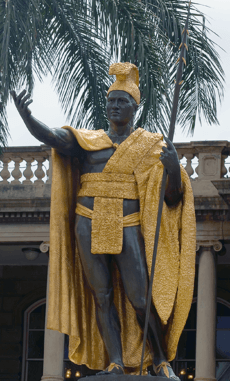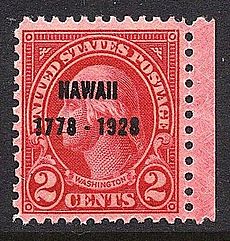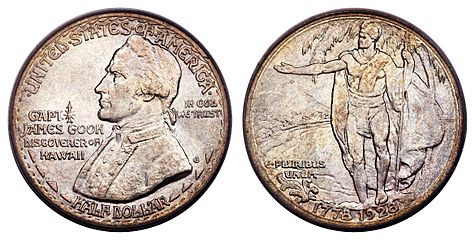Hawaii Sesquicentennial half dollar facts for kids
| United States | |
| Value | 50 cents (0.50 US dollars) |
|---|---|
| Mass | 12.5 g |
| Diameter | 30.61 mm (1.20 in) |
| Thickness | 2.15 mm (0.08 in) |
| Edge | Reeded |
| Composition |
|
| Silver | 0.36169 troy oz |
| Years of minting | 1928 |
| Mintage | 10,008 including 8 pieces for the Assay Commission |
| Mint marks | None, all pieces struck at Philadelphia Mint without mint mark |
| Obverse | |
|
|
|
| Design | Captain James Cook |
| Designer | Chester Beach, based on sketches by Juliette May Fraser |
| Design date | 1928 |
| Reverse | |
|
|
|
| Design | A Hawaiian chieftain with extended arm; Waikiki Beach and Diamond Head in background |
| Designer | Chester Beach, based on sketches by Juliette May Fraser |
| Design date | 1928 |
The Hawaii Sesquicentennial half dollar is a special coin made in 1928 by the United States Mint. It was created to celebrate the 150th anniversary of Captain James Cook's arrival in Hawaii. He was the first European explorer to reach these islands.
The front of the coin (called the obverse) shows Captain Cook. The back (called the reverse) features a Hawaiian chieftain. Only 10,000 of these coins were made for the public. This makes the coin quite rare and valuable today.
In 1927, the government of the Territory of Hawaii asked the U.S. government to make a special coin. They wanted to mark the 150th anniversary of Cook's arrival. Surprisingly, Treasury Secretary Andrew Mellon agreed, which was unusual for him. The bill to create the Hawaii half dollar easily passed through Congress. President Calvin Coolidge signed it into law on March 7, 1928.
Sculptor Chester Beach created the coin's models based on drawings by Juliette May Fraser. Beach faced some challenges getting his designs approved. Both the Mint and Victor Stewart Kaleoaloha Houston, Hawaii's representative in Congress, had concerns. Eventually, these issues were fixed, and the coin was produced. Even though the coin cost $2, which was a lot for a half dollar back then, it sold out quickly. Today, these coins are worth over a thousand dollars.
Contents
Why the Coin Was Made
The Hawaii Sesquicentennial half dollar was created to celebrate a big event. It marked 150 years since Captain James Cook first arrived in the Hawaiian Islands. People called this event "its discovery" back then. Planners decided to hold the celebrations in August 1928. This date was chosen because it was halfway between Cook's first landing in January 1778 and his death in the islands in February 1779.
The government of the Territory of Hawaii passed a resolution. This made the celebrations official. They also asked the U.S. government for help. They wanted the armed forces to join in. They also asked Washington to invite the United Kingdom (Cook's home country) and other nations. The resolution also requested a special half dollar coin and postage stamps for the anniversary.
At that time, the government didn't sell commemorative coins directly. Instead, Congress chose an organization to buy the coins at their face value. This group would then sell them to the public for a higher price. For the Hawaii half dollar, the Cook Sesquicentennial Commission of Hawaii was chosen. They would handle the sales.
Bruce Cartwright, Jr. was in charge of choosing the coin's design for the Cook commission. He met Juliette May Fraser, a local artist. Cartwright had some basic drawings ready. His drawing of Cook was based on a special plaque. Fraser quickly created her own sketches within two days. On November 2, Charles Moore, who led the Commission of Fine Arts, said Fraser's sketches were excellent. He believed they would look great on a coin.
The Commission of Fine Arts decided to ask a famous sculptor, Chester Beach, to create the final models. He would turn Fraser's sketches into plaster models. These models would then be used by the Mint to make the actual coins.
How the Coin Became Law
Historians believe that members of the United States House Committee on Coinage, Weights, and Measures likely agreed to support a Hawaii half dollar early on. This is because preparations for the coin had already begun. The bill to create the coin was introduced in the House of Representatives. It was presented by Victor Stewart Kaleoaloha Houston, Hawaii's representative in Congress, on December 5, 1927.
The bill went to the coinage committee. They held meetings about it on January 23, 1928. Delegate Houston spoke in favor of his bill. To everyone's surprise, he had a statement from Treasury Secretary Andrew Mellon. Mellon said he did not oppose the bill. This was unusual because Mellon often argued that a medal should be made instead of a coin.
Congressman Ole J. Kvale, a committee member, was very curious. He asked why Mellon was so supportive this time. Kvale, whose ancestors were from Norway, wondered why Hawaii was getting special treatment. He asked why a small group of people in Hawaii were favored over millions in the United States.
Houston said he hadn't tried to convince the Treasury. The committee chair, Randolph Perkins, thought it might be because Hawaii was far from the mainland U.S. Houston explained that the coin would be a special souvenir. It would be for people attending the celebration and for visitors. Kvale said he would vote for the bill. The bill passed the House of Representatives on February 20, 1928.
The Senate received the bill the next day. On February 27, Senator Peter Norbeck reported the bill back to the Senate. He included a letter from Secretary Mellon. In the letter, Mellon explained why he didn't oppose the Hawaii coin. He said only a small number of coins would be made. He also said the celebration, sponsored by the territorial government, was important for the whole nation.
The bill passed the Senate on March 2 without any objections. President Calvin Coolidge signed it into law on March 7. The law allowed for up to 10,000 half dollars to be made. The money earned from selling the coins would help create a Captain James Cook collection. This collection would be kept in Hawaii's official archives.
Getting the Design Ready
After sculptor Chester Beach accepted the job on March 12, 1928, he received Juliette Fraser's sketches. By April 7, he sent his finished models to the Mint. He also sent photos to the Fine Arts Commission. Both the Mint and Delegate Houston had criticisms.
The Mint said the coin's design had parts that stuck out too much (high relief). This would make it hard to produce the coins. On April 19, Mint Chief Engraver John R. Sinnock wrote that the coin would be very difficult to make. This was because the highest points on both sides of the coin were in the same spot. Beach agreed to make these high points lower.
Delegate Houston had many small complaints about the design. For example, Beach had put an anklet on the chief's leg. Houston felt that Hawaiians wouldn't have worn such an item. Beach defended some of his choices, but he removed the anklet when Houston insisted. Houston was still not happy, even about the shape of the palm tree. Beach changed the design again.
Beach sent the final models, saying he would only make more changes if the Mint asked. He even joked that Houston should take him and his family to Hawaii. He wanted to "live in the cocoanut trees" to understand the Hawaiian culture better.
The Commission of Fine Arts approved the coin. On May 9, the Mint wrote to Beach that Secretary Mellon had also approved the design.
What the Coin Looks Like

The front of the coin, the obverse, shows Captain James Cook. He is looking towards a compass needle. The words "CAPT. JAMES COOK DISCOVERER OF HAWAII" are also there. This means he is looking west. The phrase "IN GOD WE TRUST" is on the right. The country's name is above, and "HALF DOLLAR" is below.
The words "HALF DOLLAR" have eight triangles next to them, four on each side. These triangles stand for the eight largest volcanic islands of Hawaii. These islands are Oahu, Maui, Kauai, the "Big Island" of Hawaii, Niihau, Lanai, Kahoolawe, and Molokai. You can find the designer's initials, "CB," to the right of Cook's shoulder.
The back of the coin, the reverse, is based on a famous statue of King Kamehameha I of Hawaii. This statue was meant to show the past and future greatness of the Kingdom of Hawaii. The coin shows a Hawaiian chieftain in special clothing. He stands on top of a hill with his arm stretched out, as if greeting someone. He represents Hawaii rising into importance.
A palm tree rises above him, meant to symbolize romance. In the background, you can see a Hawaiian village at Waikiki Beach with Diamond Head nearby. These parts represent history and old times. The design has very little writing. You can only see "E PLURIBUS UNUM" ("Out of many, one") and the dates "1778 1928." There are also ferns under the Latin motto. Delegate Houston wanted the ferns removed, but Beach kept them to make the design balanced.
An art expert named Cornelius Vermeule thought the front of the coin was too crowded. He also felt that the back had too many elements for one small coin.
Making and Selling the Coin

The Philadelphia Mint made 10,008 Hawaii Sesquicentennial half dollars in June 1928. Eight of these coins were extra. They were saved for testing at the yearly Assay Commission meeting in 1929. Fifty of the 10,000 coins were given a special "sandblast proof" finish. These very detailed coins were given to important people and groups. This included members of the Cook commission, President Coolidge, and the British Admiralty.
The remaining coins were split. Half were sold in the Hawaiian Islands, and half were for orders from other places. The Bank of Hawaii was in charge of selling the coins for the Cook commission. Each coin cost $2, which was the highest price for a commemorative half dollar at that time.
Sales started on October 8, 1928, and the coins sold out very quickly. Some coin experts say there were rumors of hidden groups of coins. These rumors suggested that as many as 1,500 coins meant for Hawaiians were kept off the market. One such group of 137 coins was from an amount given to the Bank of Hawaii to sell to its employees. When the bank's display coin was stolen, the bank president stopped selling the others. They stayed in the bank's vaults until 1986, when they were finally sold at an auction. Many Hawaii Sesquicentennial half dollars were bought by people who weren't coin collectors. Because of this, many coins today show signs of not being handled carefully.
The Captain Cook Memorial Collection was partly bought with money raised from these coins. It is now kept at the Bishop Museum in Honolulu. The Hawaii Sesquicentennial coin is the rarest commemorative half dollar based on its design. According to a coin guide from 2015, it can be worth between $1,850 and $11,000, depending on its condition. The special "sandblast proof" coins are listed for up to $50,000. However, none have been sold at auction recently. A very good regular coin sold for $25,850 in 2013. At least three different fake versions of this coin are known to exist.


